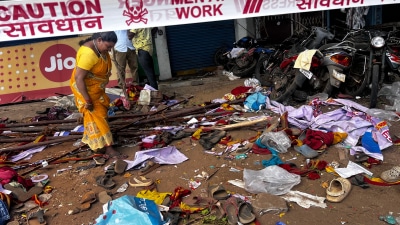Stay updated with the latest - Click here to follow us on Instagram
Gujarat farmer earns Rs 5 per unit for selling solar power produced in his farm
Raman Parmar was handed over a cheque of Rs 7500 for the 1500 units of surplus power that was produced in his farm and was fed to the electricity grid during the last four months.
 Raman Parmar from Thamna village of Anand district in Gujarat is perhaps first farmer to have his solar-powered irrigation pump connected with the electricity grid. (Source: Express photo)
Raman Parmar from Thamna village of Anand district in Gujarat is perhaps first farmer to have his solar-powered irrigation pump connected with the electricity grid. (Source: Express photo)
Raman Parmar, a native of Thamna village in Anand district of central Gujarat, is perhaps the first farmer in the country to sell power harvested from his own farm.
On Friday, Raman Parmar was handed over a cheque of Rs 7500 for the 1500 units of surplus power that was produced in his farm and was fed to the electricity grid during the last four months. The payment was made by International Water Management Institute (IWMI), which with the help of MGVCL (Madhya Gujarat Vij Company Ltd) — a state electricity discom — has set up this demonstration project in the village, as a viable business model for farmers who wish to harvest solar energy and add to their agricultural incomes.
The project in this village demonstrates an 8 kWp (kilowatt peak) grid-tied solar system that allows Parmar to evacuate surplus power to the grid at Rs 5 per unit when he is not using his 7.7 HP (Horsepower) irrigation pump.
[related-post]
“This is the first step towards creating solar cooperatives in Gujarat. Through this demonstration project we trying to show how the farmer can earn by harvesting solar power from his fields. In doing so, we are incentivising the farmer for not overdrawing ground water (because the solar power can be fed to the grid only when the solar pump is switched off), we are cutting down on carbon emission (as a solar device is being used) and preventing the farmer from using the heavily subsidised power that is supplied to him,” said Tushaar Shah, an economist, public policy specialist and a senior fellow at IWMI, a non-profit, scientific research organisation headquarted in Colombo.
The solar-powered irrigation pump installed in Raman Parmar’s farm can generate about 40-45 unit of solar power every day. This is huge cost saving for the state discoms considering the fact that the farmers in Gujarat are getting subsidised power at an average rate of 56 paise per unit, while the state is buying one unit of power at an average rate of Rs five per unit, experts point out.
“The biggest benefit of this technology is that I have access to eletricity during the day and I do not have to wake up at night to irrigate my farm that is spread over 12 bighas (close to five acres). Secondly, there is a 50 percent cut in my electricity bills,” says Parmar.
The cost of installing the solar-powered irrigation pump in Parmar’s farm is about Rs 8.5 lakh which will has been borne by IWMI. The area of about 100 square meters that have been taken up by the solar panels is being used by Parmar to grow vegetables.
“The next step is to create a create a solar cooperative in the state by bringing together 40-50 farmers in a village. This initiative will be known as Solar Pump Irrigator’s Cooperative Enterprise (SPICE) which has received an in-principal approval from MGVCL. This will happen once farmers from nearby areas come and see this demonstration project and realise it’s potential,” said Shah. MGVCL and IWMI will be associating with GERMI (Gujarat Energy Research and Management Institute) for setting up this solar cooperatives for farmers.
Under this cooperative, we are trying to connect farmers with solar-powered irrigation pumps to the electricity grid. MGVCL will meter the power generated by the farmers and will pay about Rs 3 per unit generated, Shah said adding that the cost of installing the solar-powered irrigation pumps will be borne by MGVCL.







